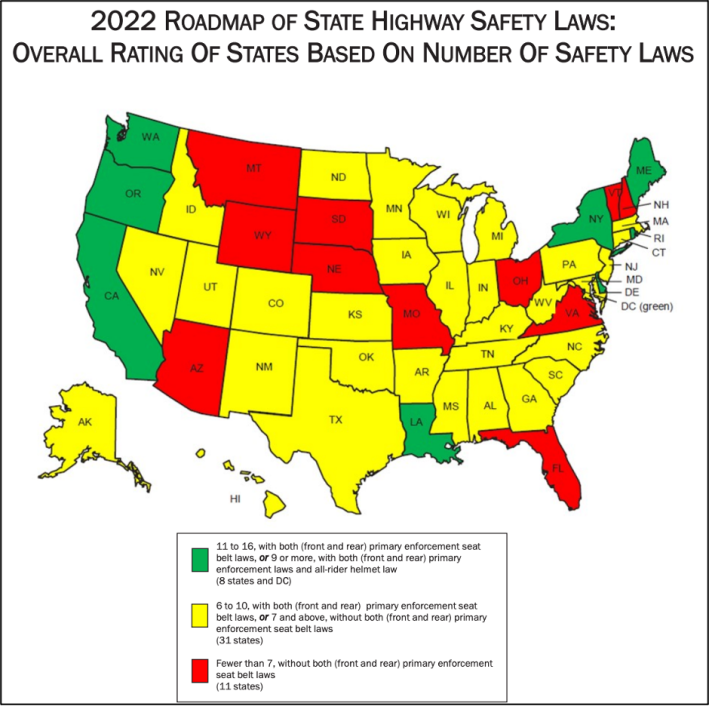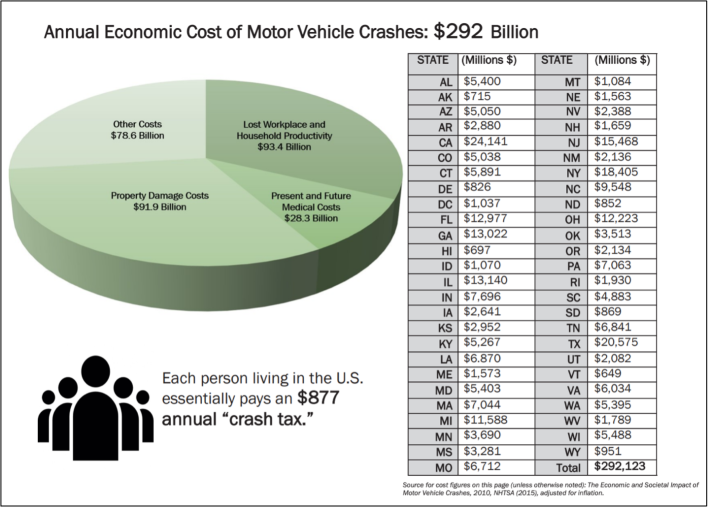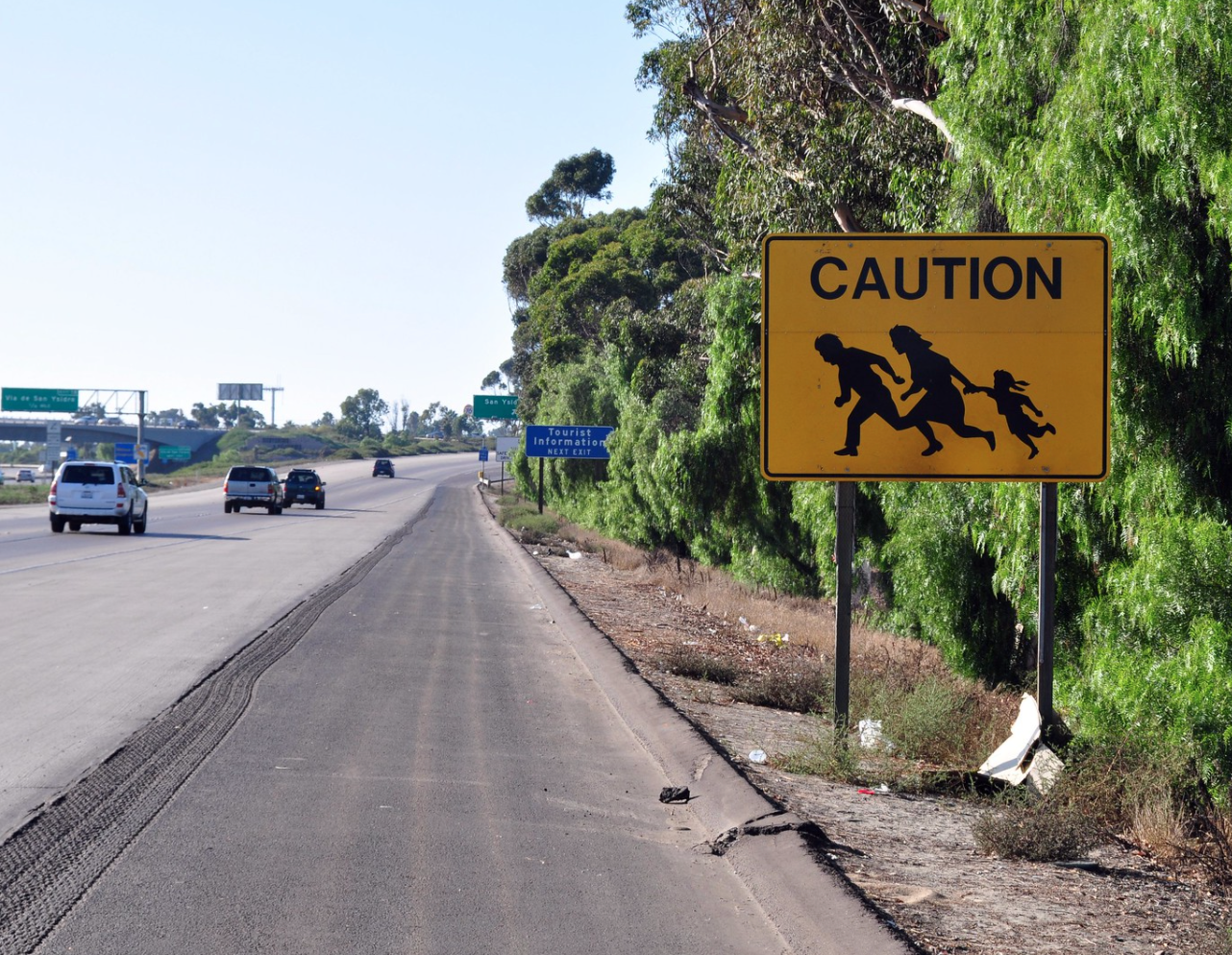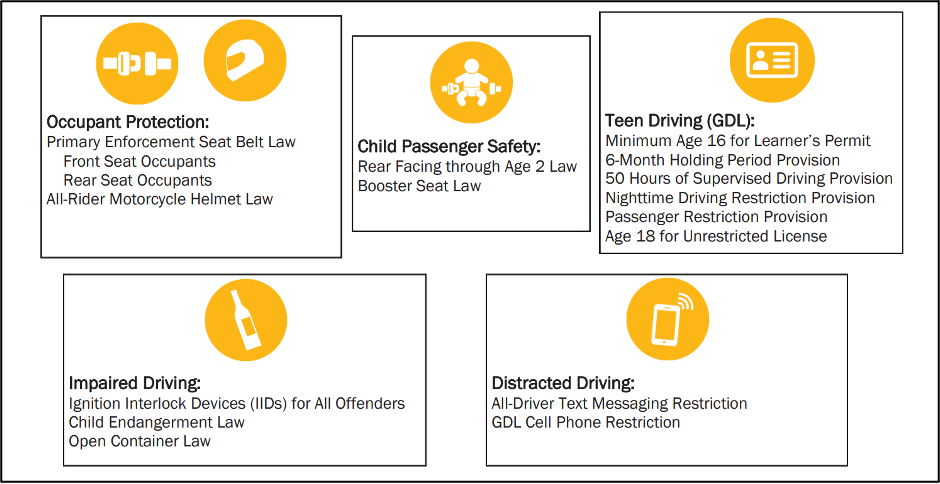More than 40 states have failed to adopt common-sense laws that advocates say would prevent many of the most easily avoidable crash deaths — and that reluctance to do the bare minimum doesn't bode well for those states' potential to more comprehensively reimagine their approaches to traffic safety.
As part of its annual Roadmap of State Highway Safety Law report, nonprofit Advocates for Highway and Auto Safety graded all 50 states and the District of Columbia based on whether (or not) they'd adopted 16 foundational traffic safety policies related to drunk and distracted driving, as well as stronger licensing requirements for child drivers, and vehicle occupant protections.
The states of Missouri and Wyoming tied for the worst on the list, having each passed just three of the recommended 16 laws, with Montana not far behind at just four. In the first two states, it is legal for drivers to have open containers of alcohol in their cars, provided they're found on the passenger's side when the driver is pulled over, and Missouri and Montana both allow drivers to send and read text messages behind the wheel, which the report authors say research has shown to be "equivalent to the behavior of drivers at the threshold of the legal limit for alcohol."
New York and Rhode Island tied for the best, though both were still missing three of the 16 recommended laws, including critical policies related to teaching safe driving techniques to notoriously dangerous teen motorists. According to the Insurance Institute for Highway Safety, the crash rate for child drivers is three times that of adults, in part because many states do not use graduated licensing programs that restrict their driving privileges until they're older and have logged significant supervised practice hours on the road.

Notably, none of the policies on the Advocates for Highway and Auto Safety's wishlist is particularly earth-shattering — and many have been considered best practices in other countries (and a handful of forward-thinking states) for decades.
They include:
- Requiring motorists convicted of drunk-driving offenses in the past to have devices installed on their cars that prevent them from starting the vehicles when they're over the legal blood alcohol limit, based on an on-board breath test.
- Outlawing texting behind the wheel, which "causes the driver’s eyes to be off the road for an average of 4.6 seconds," or "the equivalent of driving blind the entire length of a football field" when a car is traveling 55 miles per hour.
- Applying strict licensing requirements on children under 18 years old, who are easily the most dangerous drivers on the road by many metrics, including having the highest rate of killing pedestrians and cyclists of any age group.
- Obligating all occupants of vehicles to use basic safety equipment, including seatbelts for car passengers, rear-facing car seats for babies under two years old, and helmets for high-speed motorcycle riders — and giving law enforcement officers the ability to pull drivers over specifically for those offenses, rather than restricting them to writing tickets when the driver is stopped for a different infraction
The group emphasized that their recommended policies aren't a silver bullet, and that they can't stem the rising tide of crash deaths on American roads alone. Federal safety agencies project roadway fatalities will reach a 15-year high once the numbers from 2021 are finalized, in large part due to increases in speeding, distraction and impaired driving.
But in concert with building safe roadway infrastructure, people-centered land use reforms, strong automotive safety standards, and strong reforms to protect motorists of color from police violence, some advocates say these laws could prevent some of the most truly egregious roadway crimes — or to put it another way, they could provide a floor, rather than a ceiling, to a safe national transportation system.
"These 16 laws do not comprise the entire list of effective public policy interventions states should take to reduce motor vehicle deaths and injuries," the report authors wrote. "Rather, they are minimum critical traffic safety laws."
Some advocates say that even these aggressive safety reforms would still set the bar pretty low — particularly when it comes to drunk driving.
According to research cited in the report, experts estimate that the first time a driver is cited for driving under the influence, he will have already driven drunk a stunning 87 times on average before he was caught — and that all of those instances could be prevented if Interlock Ignition Device technology came standard on all cars. The recently passed Infrastructure Investment and Jobs Act will require automakers to install anti-drunk-driving tech on all new vehicles by 2026, but it won't need to be installed on the millions of cars already on the road, and in the meantime, 16 states still don't even require people who have a proven history of drunk driving to adopt the technology.
That won't address the underlying problem of how to provide transportation options besides driving for travelers who have had a few, at least in the most deeply auto-centric communities — but it would at least force recidivist DUI offenders who do have access to other modes like taxis, buses and rides from friends to actually use them.

Perhaps the best argument for adopting strong roadway safety laws, though, is that even the most car-crazy Americans want them — and states can answer their call for better policies right now.
In a companion study commissioned at the time of the report, more than two thirds of respondents said that "not enough is being done to reduce dangerous driving behavior on our roadways," and the majority added that they were either "very" or "extremely" concerned about the roadway behaviors the Advocates' recommended policies would help address, regardless of where they lived or their political affiliation.
The report authors say that's evidence enough that state leaders should act now.
"Not only are these actions supported by data, research, and experience, the poll also demonstrates the public’s concern and desire for change," said Advocates for Highway and Auto Safety President Cathy Chase. "Allowing this carnage to occur year after year, when solutions are readily available, is simply unacceptable."







